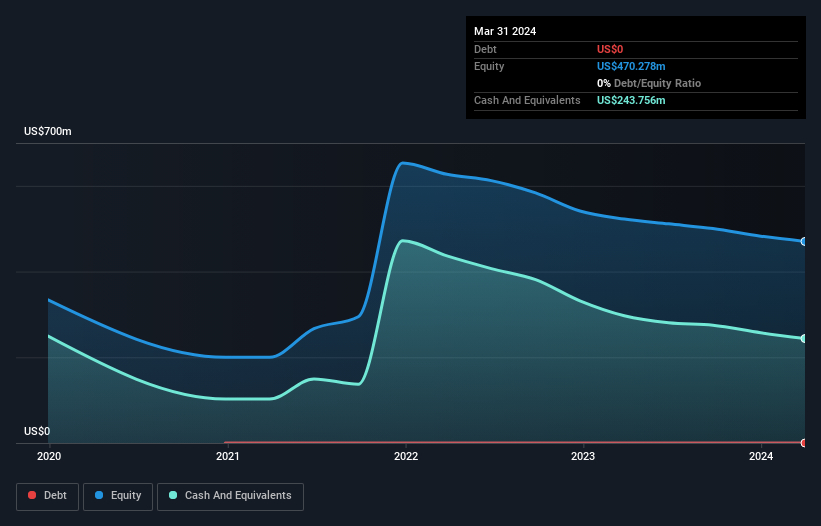- United States
- /
- Hospitality
- /
- NYSE:SG
Here's Why We're Not At All Concerned With Sweetgreen's (NYSE:SG) Cash Burn Situation

Just because a business does not make any money, does not mean that the stock will go down. By way of example, Sweetgreen (NYSE:SG) has seen its share price rise 143% over the last year, delighting many shareholders. But the harsh reality is that very many loss making companies burn through all their cash and go bankrupt.
In light of its strong share price run, we think now is a good time to investigate how risky Sweetgreen's cash burn is. In this article, we define cash burn as its annual (negative) free cash flow, which is the amount of money a company spends each year to fund its growth. First, we'll determine its cash runway by comparing its cash burn with its cash reserves.
View our latest analysis for Sweetgreen
Does Sweetgreen Have A Long Cash Runway?
A company's cash runway is the amount of time it would take to burn through its cash reserves at its current cash burn rate. In March 2024, Sweetgreen had US$244m in cash, and was debt-free. In the last year, its cash burn was US$45m. That means it had a cash runway of about 5.4 years as of March 2024. While this is only one measure of its cash burn situation, it certainly gives us the impression that holders have nothing to worry about. You can see how its cash balance has changed over time in the image below.

How Well Is Sweetgreen Growing?
Happily, Sweetgreen is travelling in the right direction when it comes to its cash burn, which is down 68% over the last year. And revenue is up 25% in that same period; also a good sign. We think it is growing rather well, upon reflection. While the past is always worth studying, it is the future that matters most of all. So you might want to take a peek at how much the company is expected to grow in the next few years.
How Hard Would It Be For Sweetgreen To Raise More Cash For Growth?
We are certainly impressed with the progress Sweetgreen has made over the last year, but it is also worth considering how costly it would be if it wanted to raise more cash to fund faster growth. Generally speaking, a listed business can raise new cash through issuing shares or taking on debt. One of the main advantages held by publicly listed companies is that they can sell shares to investors to raise cash and fund growth. By comparing a company's annual cash burn to its total market capitalisation, we can estimate roughly how many shares it would have to issue in order to run the company for another year (at the same burn rate).
Sweetgreen has a market capitalisation of US$3.2b and burnt through US$45m last year, which is 1.4% of the company's market value. That means it could easily issue a few shares to fund more growth, and might well be in a position to borrow cheaply.
How Risky Is Sweetgreen's Cash Burn Situation?
As you can probably tell by now, we're not too worried about Sweetgreen's cash burn. For example, we think its cash runway suggests that the company is on a good path. And even its revenue growth was very encouraging. After considering a range of factors in this article, we're pretty relaxed about its cash burn, since the company seems to be in a good position to continue to fund its growth. An in-depth examination of risks revealed 3 warning signs for Sweetgreen that readers should think about before committing capital to this stock.
Of course Sweetgreen may not be the best stock to buy. So you may wish to see this free collection of companies boasting high return on equity, or this list of stocks with high insider ownership.
New: Manage All Your Stock Portfolios in One Place
We've created the ultimate portfolio companion for stock investors, and it's free.
• Connect an unlimited number of Portfolios and see your total in one currency
• Be alerted to new Warning Signs or Risks via email or mobile
• Track the Fair Value of your stocks
Have feedback on this article? Concerned about the content? Get in touch with us directly. Alternatively, email editorial-team (at) simplywallst.com.
This article by Simply Wall St is general in nature. We provide commentary based on historical data and analyst forecasts only using an unbiased methodology and our articles are not intended to be financial advice. It does not constitute a recommendation to buy or sell any stock, and does not take account of your objectives, or your financial situation. We aim to bring you long-term focused analysis driven by fundamental data. Note that our analysis may not factor in the latest price-sensitive company announcements or qualitative material. Simply Wall St has no position in any stocks mentioned.
Have feedback on this article? Concerned about the content? Get in touch with us directly. Alternatively, email editorial-team@simplywallst.com
About NYSE:SG
Sweetgreen
Operates fast food restaurants serving healthy food and beverages in the United States.
Adequate balance sheet and slightly overvalued.
Similar Companies
Market Insights
Community Narratives



